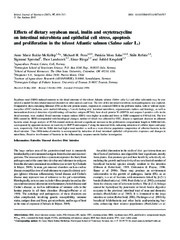Effects of dietary soybean meal, inulin and oxytetracycline on gastrointestinal histological characteristics, distal intestine cell proliferation and intestinal microbiota in Atlantic salmon (Salmo salar L.)
Permanent link
https://hdl.handle.net/10037/2103Date
2007Type
Journal articleTidsskriftartikkel
Peer reviewed
Author
Bakke-Mckellep, AM; Sperstad, Sigmund; Penn, MH; Salas, PM; Refstie, Ståle; Landsverk, Tor; Ringø, Einar; Krogdahl, ÅshildAbstract
Soyabean meal (SBM)-induced enteritis in the distal intestine of the teleost Atlantic salmon (Salmo salar L.) and other salmonids may be considered
a model for diet-related mucosal disorders in other animals and man. The role of the intestinal microbiota in its pathogenesis was explored.
Compared to diets containing fishmeal (FM) as the sole protein source, responses to extracted SBM or the prebiotic inulin, with or without oxytetracycline
(OTC) inclusion, were studied following a 3-week feeding trial. Intestinal microbiota, organosomatic indices and histology, as well as
immunohistochemical detection of proliferating cell nuclear antigen (PCNA), heat shock protein 70 (HSP70) and caspase-3-positive cells in the
distal intestine, were studied. Distal intestine somatic indices (DISI) were higher in inulin and lower in SBM compared to FM-fed fish. The low
DISI caused by SBM corresponded with histological changes, neither of which was affected by OTC, despite a significant decrease in adherent
bacteria count. Image analysis of PCNA-stained sections showed a significant increase in the proliferative compartment length in SBM-fed fish,
accompanied by apparent increases in reactivity to HSP70 and caspase-3 along the mucosal folds, indicating induction of cellular repair and apoptosis,
respectively. Fish fed the SBM diet had higher total number as well as a more diverse population composition of adherent bacteria in the
distal intestine. Thus SBM-induced enteritis is accompanied by induction of distal intestinal epithelial cell protective responses and changes in
microbiota. Putative involvement of bacteria in the inflammatory response merits further investigation.
Description
This is the publishers version/PDF (institutional repository or PubMed Central can publish publishers version after 12 month embargo)


 English
English norsk
norsk